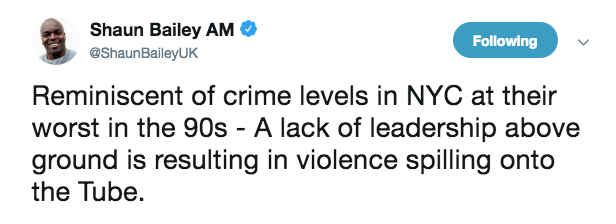Violent crime is a horrible thing and public anxiety about it eats into a city’s peace of mind, eroding its people’s self-confidence and troubling its soul. Politicians who make light of it, or even appear to, can pay a heavy price, and sometimes it serves them right. But the same goes for those who foster a climate of fear about crime with emotive rhetoric and wild claims. Conservative London Mayor candidate Shaun Bailey should bear that in mind.
Last week, Bailey claimed on Twitter that British Transport Police figures showing in increase in offences involving violence on the London Underground in the past two or three years are, “Reminiscent of crime levels in NYC [New York City] at their worst in the 90s – A lack of leadership above ground is resulting in violence spilling on to the Tube.” Leaving aside questions about the true meaning and significance of Tube crime data as a whole, is any such comparison with the New York of the 1990s valid?
Let’s begin at the start of that decade with the most stark violent crime figure of all – the total number of homicides. In New York in 1990 that hit a truly shocking all-time high of 2,245 (or 2,262 according to a different definition). There has been justified concern that the number of homicides in London last year was the largest since 2009. However, the London total of 132 in 2018 was nowhere near that of New York in 1990. The New York of the 1990s actually saw a steady and marked decline in crime across the board, but even in 1997 there were 767 killings – still nearly six times the number in London last year. Coming right up to date, reports from New York say there were 289 homicides there in 2018. That’s a record low, but still many more than in London, a city of similar population size.

Comparing figures for other types of violent and crime and crime in general in the New York of the 1990s and the London of today is not as easy a task and might be practically impossible – another reason for politicians to be wary of making large generalisations. It’s fair to say, though, that New York’s violent crime story of that time was pretty grim, seen by police and others as closely tied to the state of the illegal drug market, most significantly the advent of crack cocaine in the mid 1980s. “It spread like wildfire,” said an NYPD police sergeant in charge of combatting robbery. The decline in crime during the 1990s is also linked to further changes in the drug market, as well as the interaction between that and new policing approaches introduced in New York during the same period (UK criminologist Ben Bowling’s work on this is well worth reading).
London today has good reason to be perturbed by the evolving role of its drug market in some violent criminality, including the exploitation of children by gangs. It is right that politicians debate this and it can be difficult for them – and for journalists – to find the right way to express concern without being unhelpfully alarmist. The assertion by Tory AM Susan Hall at Mayor’s Question Time last week that, “Everywhere is dangerous now in London,” fell on the wrong side of the line. And Shaun Bailey making scary comparisons with a past New York, still synonymous with urban jungle mean streets despite nowadays being ranked one of the safest big cities in the world, is a clumsy approach to put it kindly.
Bailey is perfectly entitled to criticise the Mayor he hopes to replace. But if he wants better leadership on crime, he should perhaps get round to showing some himself.

